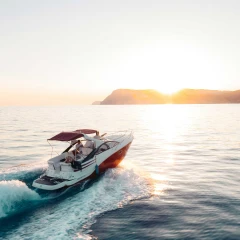Where Should I Store My Boat in the Off-Season?
When boating season winds down, one of the biggest questions is where to store your boat until next year. The decision isn’t just about convenience — your choice may affect your insurance rate, your coverage requirements, and your boat’s long-term condition.
Insurance Note: Coverage and pricing impacts vary by insurer, location, and policy type. Always confirm with your provider before making storage arrangements.
1. Dry Stack Storage
What It Is: Boats are stored in a covered facility on racks, stacked vertically. A forklift moves your boat in and out of the water.
Potential Insurance Impact:
- Often seen as lower risk for theft and weather damage, which may help reduce your premium.
- Some insurers require that the facility meet certain security or weather-protection standards for any discount to apply.
Possible Complications:
- Limited access during off-hours.
- Size and weight restrictions — not all boats fit in standard racks.
- Demand is high in popular boating areas, so space may be hard to secure.
2. Indoor Heated Storage
What It Is: Your boat is stored inside a climate-controlled building through the off-season.
Potential Insurance Impact:
- Can reduce risk of freezing-related damage, theft, and vandalism.
- Some insurers consider this the “gold standard” for off-season storage, but rates still depend on location and facility security.
Possible Complications:
- More expensive than other options.
- Limited availability — may need to reserve months ahead.
- You may need to drain fuel or disconnect batteries per facility rules.
3. Outdoor Marina Storage (on Land)
What It Is: Your boat sits on a trailer or cradle in a marina yard, often shrink-wrapped or tarped.
Potential Insurance Impact:
- Greater exposure to weather and possible theft may increase premiums compared to indoor storage.
- Proper winterization is often required to maintain coverage (subject to policy terms and exclusions) for freeze-related claims.
Possible Complications:
- Storms and high winds can damage covers or shift boats in cradles.
- Must check marina security measures (fencing, cameras, patrols).
4. Driveway or Backyard Storage
What It Is: Keeping your boat on your property, usually on a trailer.
Potential Insurance Impact:
- Often considered higher theft/vandalism risk unless secured in a locked, fenced area.
- May have no impact if your insurer rates purely on navigational territory, but some carriers do ask where the boat will be kept.
Possible Complications:
- Neighborhood covenants or city ordinances may restrict boat storage.
- Exposure to sun, ice, or debris if not covered properly.
- Your homeowners insurance usually won’t cover the boat — separate boat insurance is still needed.
5. In-Water Winter Slip
What It Is: Leaving the boat in the water during the off-season, often with bubblers or de-icers to prevent ice damage.
Potential Insurance Impact:
- Some insurers won’t allow in-water winter storage in certain climates due to the high risk of ice and storm damage.
- When permitted, this storage method typically carries higher risk for sinking, ice damage, and storms — which may increase premiums or require specific coverage endorsements.
Possible Complications:
- Requires more frequent checks for lines, fenders, and ice accumulation.
- Power outages can disable de-icing systems.
Choosing the Best Option for You
The “best” storage solution depends on your budget, local climate, access needs, and your insurer’s rules. Availability and costs can vary year-to-year, so book early if you want a preferred method like dry stack or heated indoor storage. In many cases, moving your boat to a secure, covered facility can help reduce risk — and sometimes your premium — but results depend on your insurer’s rating factors.
Final Tip:
No matter where you store your boat, document its condition with photos, remove valuables, and follow manufacturer or marina winterization guidelines.
Disclaimer: This article provides general information and is not legal or insurance advice. Storage-related risks and insurance impacts vary by location, facility, and insurer. Always confirm specific requirements and coverage details with your licensed insurance provider.














